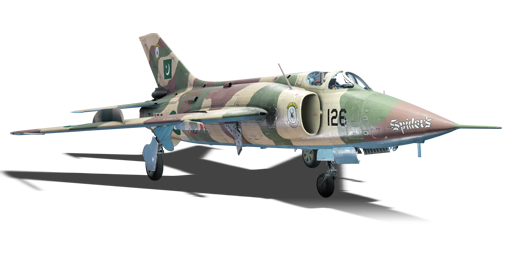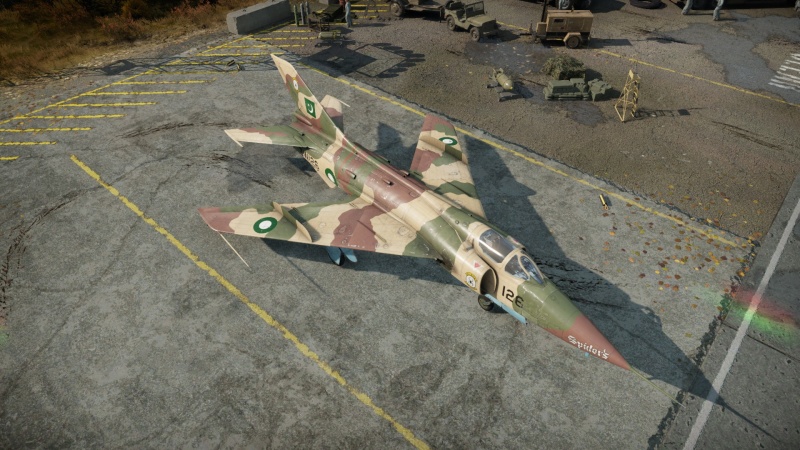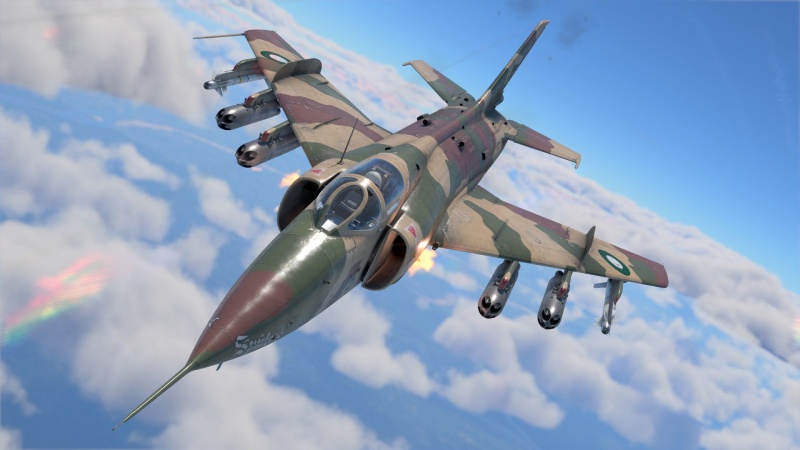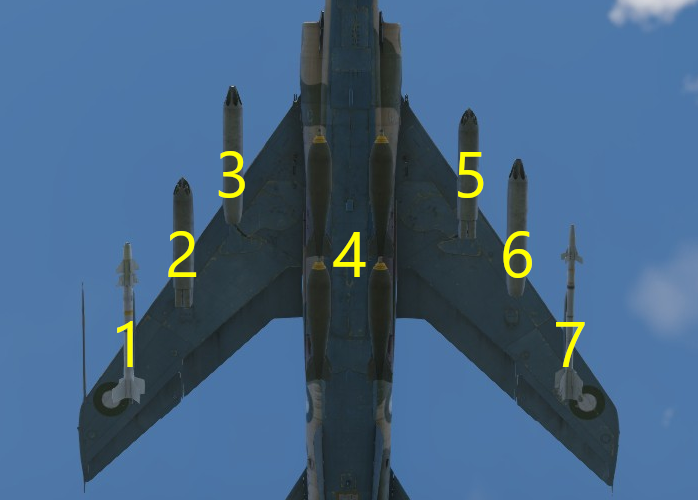A-5C
| This page is about the Chinese strike aircraft A-5C. For other versions, see Q-5 (Family). |
Contents
Description
The A-5C is a premium gift rank VI Chinese strike aircraft with a battle rating of 10.0 (AB/RB/SB). It was introduced in Update "Direct Hit".
Sharing most of the performance, appearance, and capabilities of a Q-5A, the export model A-5C comes with advanced air-to-air missiles and Western bombs which might be more familiar to French and American pilots. It retains the Q-5A's ballistic computer and can still destroy ground targets with HE rockets and unguided bombs. But the main improvement over the tech tree Fantans lies in its ability to carry AAMs on dedicated wing hardpoints. With its excellent climb rate for an attacker, a pair of deadly Magic 1s or AIM-9Ps, and somewhat superior manoeuvrability to contemporary enemies, it can punch above its weight in air combat, surprising opponents with what a MiG-19-based aircraft can do.
General info
Flight performance
The A-5C is slightly heavier than the Q-5A, but the difference is negligible and does not meaningfully affect the flight performance. The acceleration and climb are still impressive even at a whole battle rating above the Q-5A. However the limited top speed and heavy control compression at transonic and supersonic speeds are flaws not shared by contemporary MiG-21s and Phantoms for example. While the A-5C can't effectively manoeuvre at high speeds, it does have excellent energy retention in those zones and can easily perform zoom climbs and climbing spirals. The best control authority is achieved at high subsonic speeds (~600-800 km/h IAS) if there is a need for sharp turns.
| Characteristics | Max Speed (km/h at 7,000 m) |
Max altitude (metres) |
Turn time (seconds) |
Rate of climb (metres/second) |
Take-off run (metres) | |||
|---|---|---|---|---|---|---|---|---|
| AB | RB | AB | RB | AB | RB | |||
| Stock | 1,438 | 1,434 | 17000 | 25.4 | 25.7 | 139.8 | 130.0 | 900 |
| Upgraded | 1,458 | 1,447 | 24.6 | 25.0 | 186.2 | 162.0 | ||
Details
| Features | |||||
|---|---|---|---|---|---|
| Combat flaps | Take-off flaps | Landing flaps | Air brakes | Arrestor gear | Drogue chute |
| X | ✓ | ✓ | ✓ | X | ✓ |
| Limits | ||||||
|---|---|---|---|---|---|---|
| Wings (km/h) | Gear (km/h) | Flaps (km/h) | Max Static G | |||
| Combat | Take-off | Landing | + | - | ||
| 1,260 | 577 | N/A | 500 | 450 | ~9 | ~5 |
| Optimal velocities (km/h) | |||
|---|---|---|---|
| Ailerons | Rudder | Elevators | Radiator |
| < 540 | < 650 | < 350 | N/A |
Engine performance
| Engine | Aircraft mass | ||||||
|---|---|---|---|---|---|---|---|
| Engine name | Number | Basic mass | Wing loading (full fuel) | ||||
| Shenyang Liming WP-6A-III | 2 | 6,712 kg | 341 kg/m2 | ||||
| Engine characteristics | Mass with fuel (no weapons load) | Max Takeoff Weight | |||||
| Weight (each) | Type | 10m fuel | 20m fuel | 30m fuel | 34m fuel | ||
| 725 kg | Afterburning axial-flow turbojet | 7,560 kg | 8,329 kg | 9,138 kg | 9,539 kg | 12,000 kg | |
| Maximum engine thrust @ 0 m (RB/SB) | Thrust to weight ratio @ 0 m (WEP) | ||||||
| Condition | 100% | WEP | 10m fuel | 20m fuel | 30m fuel | 34m fuel | MTOW |
| Stationary | 2,651 kgf | 3,706 kgf | 0.98 | 0.89 | 0.81 | 0.78 | 0.62 |
| Optimal | 2,679 kgf (1,000 km/h) |
3,783 kgf (1,000 km/h) |
1.00 | 0.91 | 0.83 | 0.79 | 0.63 |
Survivability and armour
- 10 mm steel plate behind nose cone
- 60 mm bulletproof glass in cockpit front
- 8 mm steel plate underneath cockpit
- 25 mm steel armoured pilot's seat
- 10 + 16 mm steel armoured pilot's headrest
- Self-sealing fuel tanks behind cockpit and underneath engines in rear fuselage
The A-5C protects the pilot from small arms fire, but against the armaments encountered at the battle rating, this level of protection does not amount to much. Enemy cannons and missiles will make short work of the A-5C so avoiding incoming fire is paramount. The twin engines are likely to be damaged by attacks from the rear, but having two of them offers some extra survivability since it is capable of flying back to base on one engine. The aircraft also remains somewhat controllable if one of the elevators is blown off.
Modifications and economy
Armaments
| Ballistic Computer | |||
|---|---|---|---|
| CCIP (Guns) | CCIP (Rockets) | CCIP (Bombs) | CCRP (Bombs) |
| |
|
|
|
Offensive armament
The A-5C is armed with:
- A choice between two presets:
- 2 x 23 mm Type 23-2K cannons, wing-mounted (120 rpg = 240 total)
- 2 x 23 mm Type 23-2K cannons + 18 x countermeasures
The A-5C is equipped with the same Type 23-2K cannons as the other Fantan models. They fire rapidly and have a decent ammunition supply by Soviet/Chinese standards, but the muzzle velocity leaves something to be desired when fighting supersonic aircraft and the damage from individual shots can be inconsistent. They are not very suited for high-speed snapshots or head-ons but are still important backup weapons for when the A-5C runs out of missiles.
The ballistic computer grants CCIP functionality for the guns, which can be useful for harassing light ground targets if other ordnance is unavailable. However the AP-T rounds do not have enough penetration to threaten MBTs.
Suspended armament
The A-5C can be outfitted with the following ordnance presets:
- Without load
- 2 x AIM-9P Sidewinder missiles
- 2 x Matra R550 Magic 1 missiles
- 28 x Type 90-1 rockets
- 16 x Type 130-2 rockets
- 4 x 500 lb LDGP Mk 82 bombs (2,000 lb total)
- 4 x 750 lb M117 cone 45 bombs (3,000 lb total)
- 2 x Matra R550 Magic 1 missiles + 28 x Type 90-1 rockets + 4 x 500 lb LDGP Mk 82 bombs (2,000 lb total)
- 2 x Matra R550 Magic 1 missiles + 16 x Type 130-2 rockets + 4 x 750 lb M117 cone 45 bombs (3,000 lb total)
- 2 x AIM-9P Sidewinder missiles + 28 x Type 90-1 rockets + 4 x 750 lb M117 cone 45 bombs (3,000 lb total)
- 2 x AIM-9P Sidewinder missiles + 16 x Type 130-2 rockets + 4 x 250 kg Type 250-2 bombs (1,000 kg total)
As an export model operated by Pakistan, the A-5C has different toys to play with than the PLAAF's Q-5A. It has a new pair of outboard wing hardpoints exclusively reserved for air-to-air missiles, and very potent missiles at that. The French Matra Magic 1, made famous by the Mirage IIIC, is one of the most manoeuvrable missiles in War Thunder with a 35 G overload. Launching them within 2 km will generally seal the fate of non-flaring targets. The American AIM-9P, identical in performance to the AIM-9J used by the F-4E and F-5E, is less manoeuvrable with a 20 G overload but tends to have a longer effective range and is thus more effective for sneak attacks. To summarize, the AIM-9P is best used at longer ranges with its longer burn time, whereas the Magic 1s should only really be used at close range.
The unguided rockets are still the Type 90-1 HEAT rockets and Type 130-2 HE rockets used by the Q-5A. There is a slight improvement in that both models can be mounted on any of the four main wing pylons, allowing for a full load of sixteen Type 130-2 rockets to be carried.
The A-5C now has access to American bombs. The 500 lb Mk 82 bombs are not much different from the Chinese 250 kg bombs, but the 750 lb M117 bombs are significantly heavier. They have a better explosive content for base bombing and require less precision when bombing ground targets.
A nice feature of the A-5C is the AAMs, rockets, and bombs all have reserved hardpoints and do not interfere with each other. A fully loaded A-5C can drop a full bombload and go on rocket runs while having a pair of AAMs for air combat at all times.
Custom loadout options
| 1 | 2 | 3 | 4 | 5 | 6 | 7 | ||
|---|---|---|---|---|---|---|---|---|
| 250 kg Type 250-2 bombs | 4 | |||||||
| 500 lb LDGP Mk 82 bombs | 4 | |||||||
| 750 lb M117 cone 45 bombs | 4 | |||||||
| Type 90-1 rockets | 7 | 7 | 7 | 7 | ||||
| Type 130-2 rockets | 4 | 4 | 4 | 4 | ||||
| AIM-9P Sidewinder missiles | 1 | 1 | ||||||
| Matra R550 Magic 1 missiles | 1 | 1 |
Usage in battles
Although historically an attack aircraft, the A-5C is not a first-rate ground attacker in Air RB since its bombload is still not impressive compared to other jets at its battle rating. It cannot destroy a base with its four 250 kg/500 lb bombs, but this is still an option for supplementary research points: stay at low altitude, rush to a base, drop the bombs, then head towards the center of the map to join the furball. Going after AI ground vehicles with the bombs and rockets can also be successful provided that other jets do not arrive quickly to crash the party. The Type 130 HE rockets can also be unloaded into a base for additional points.
With a higher battle rating than the other Fantans, the A-5C starts to feel the limits of the MiG-19-based airframe when facing Mach 2-capable jets like the F-4C Phantom II. It can no longer count on being able to outrun its opponents, and the control compression makes it difficult to hit high-speed snapshots or make rapid high-speed turns to dodge missiles. It is then important to utilize the A-5C's strengths in acceleration, climb, and energy retention to maintain good positioning in dogfights. Use the flares and RWR to help avoid incoming missiles and carefully manage the airspeed with the throttle and airbrakes.
While its Chinese cousins lacked any form of AAM for self-defense, the A-5C comes with a pair of AIM-9Ps or Matra R550 Magics which prove very deadly at its battle rating. They are the reason why the A-5C is still effective in face of its airframe limitations; for example, the Magic's high manoeuvrability and wide seeker acquisition cone allows the A-5C to destroy manoeuvring enemy targets even if it is compressing and cannot manoeuvre much itself. Still, the pilot is responsible for using the missiles effectively: none can be used in the front aspect, they can be spoofed by flares, and only two of them are available. Use them against high-value targets that do not have enough time to react and consider returning to base once the missiles are spent. It is still possible for the A-5C to dogfight with guns, but the extended energy fighting the A-5C relies on makes for easy missile bait if other enemies are around.
Although the A-5C has access to great missiles for its battle rating, remember that other common attacker aircraft like the Soviet Su-25/K and the American A-10A/Late have not only highly agile, but also all-aspect missiles in the form of the R-60M and AIM-9L Sidewinder. Do not engage these aircraft in head-ons and use the A-5C's superior flight performance to take them down. Because the Frogfoot and Warthog have huge flare capacities, be prepared to use guns if convenient or necessary.
Ground RB
Similar to the Q-5A, the A-5C can be quite effective in Ground RB despite having a relatively light payload. Since the A-5C has CCIP capabilities, pilots can deliver ordnance to enemy positions or vehicles with high accuracy. Once the bombs and rockets are spent, the A-5C can switch to providing air cover with its powerful AAMs, or return to base to restock.
The A-5C can carry a good amount of Type 130-2 HE rockets. With CCIP, they can be fired from several kilometres away outside of cannon SPAA range, and easily destroy thin-skinned vehicles through overpressure or shrapnel. Even MBTs can be knocked out by hits to side or roof armour, although this requires more precision and is best attempted at closer distances. The 750 lb bombs come in four drops and can conveniently destroy static targets, armoured or not, once enemy air defense has been suppressed.
Something to remember is that the A-5C's battle rating will pit it against radar-guided SAM systems. Without precision weapons like the laser-guided bombs of the tech tree Q-5L, the A-5C cannot engage SAMs like the Roland 1 outside of their missile range. The small countermeasure capacity also makes it difficult to drop lots of chaff for breaking radar locks. Assess the battlefield and fly cautiously if there is a significant SAM presence; either sneak around at low altitude or fly very high above their radar and unleash a rain of ordnance in a dive when they are distracted.
Evading IR Missiles
The A-5's engines produce a somewhat large heat signature compared to other aircraft at its BR, in some cases even if you shut your afterburner off and try to flare/bank away from the missile, it will ignore the flares outright and go right for your engines. At high speeds, your elevators and ailerons compress significantly, preventing you from evading the missile even if you expend all 18 flares on a single missile.
In order to evade some more-flare-resistant missiles such as the AIM-9L, a good strategy is to shut off your engines completely or reducing your throttle to 0% so your heat signature is reduced significantly, drop a flare or two, then fire up your engines again and speed off. Do not attempt to aggressively bank while your engines are off or still warming up, as you could bleed enough speed to allow whoever fired the missile at you a chance to get their guns locked on you. Once your engines are up to temperature again and producing maximum thrust, then you can bank to try to evade any future missile, this best works against slower targets like the A-10 or Su-25 which both carry 30-35 G all-aspect AAMs of the AIM-9L and R-60M/MK respectively. Avoid trying this tactic against jets like the F-4C or MiG-21s, as they can catch up to you at lower altitudes, especially at speeds approaching Mach 1.
Pros and cons
Pros:
- High acceleration, great energy retention, and decent climb rate
- Good sustained manoeuvrability, can out-turn F-4 Phantoms and keep up with MiG-21s
- Can carry decent numbers of powerful HE rockets
- Excellent AIM-9P or R550 Magic missiles for air combat
- Has access to more powerful bombs than earlier Q-5 models
- CCIP for gun, rockets and bombs
Cons:
- Average roll rate, much slower than shorter-winged opponents such as Yak-38 and Jaguar
- Rudder and elevators lock up at high speeds (>1000 km/h)
- Lower top speed than many opponents
- The 23 mm cannons sometimes fall short in damage, much less lethal than J-6A's 30 mm cannons
- Ordnance capacity is still below average for its rank
- The amount of flares is quite limited
History
In view of the economy after the Cultural Revolution and the dawn of the economic reform in Mainland China, the Central Government decided that all exported weapons would be priced and handled by the newly established CATIC. In mid-1979, Egypt became their first overseas customer with orders of new jets and engines; meanwhile, Pakistan had concluded that the main culprit for the lost of 3rd Indo-Pakistan War was because of the lack of a dedicated ground attacker, in fear of possible assaults from USSR via Afghanistan, they were in dire need for a new ground attacker.
Pakistan then sent 2 teams of staffs to Nanchang Aircraft Corporation and it was concluded that Q-5 would be a fair option for an attacker with its low-altitude performance and price, but it would also be upgraded with Western avionics, weaponries and came with IR AAMs for self-defense. Based on the Q-5IA that was still under development, Nanchang Aircraft Corp. built 3 prototypes in 1982 and the newly designated A-5C was delivered to the PAF from early 1983 to 1984, with 54 of them built through out the year.
A-5C was then delivered to three different PAF squadrons and some of them retired as early as 1991, while the remaining were kept in commission until mid-2011, when the more-advanced JF-17 Thunder replaced them as a multi-role fighter. Other export variants remain in service at Myanmar and Sudan.
Media
- Skins
- Videos
See also
- Related development
External links
| Nanchang Aircraft Manufacturing Corporation 南昌飞机制造公司 | |
|---|---|
| Strike aircraft | Q-5 early · Q-5A · Q-5L |
| A-5C | |
| China jet aircraft | |
|---|---|
| Fighters | J-2 · J-4 · Shenyang F-5 · J-6A · J-7II · J-7D · J-7E · J-8B · J-8F · J-11 |
| Strike aircraft | Q-5 early · Q-5A · Q-5L · A-5C · JH-7A |
| Bombers | H-5 |
| American | ␗F-84G-21-RE · ␗F-84G-31-RE · ␗F-86F-30 · ␗F-86F-40 · ␗F-100A · ␗F-100F · ␗F-104A · ␗F-104G · ␗F-5A · ␗F-5E · ␗F-16A MLU |
| Soviet | ␗MiG-9 · ␗MiG-9 (l) |
| China premium aircraft | |
|---|---|
| Fighters | ␗A6M2 · D.510C · H-81A-2 · Hawk III · ␗Ki-45 hei/tei · ␗Ki-84 ko |
| Jet fighters | Shenyang F-5 · J-7D |
| Strike aircraft | A-5C · ␗F-84G-31-RE |







